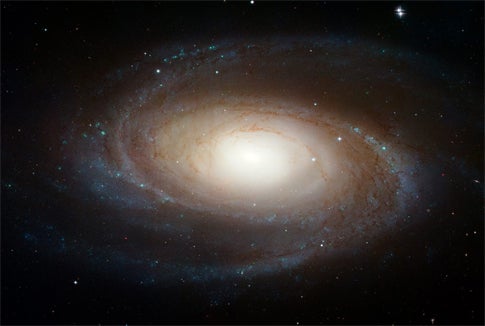Observations with Subaru Telescope’s Prime Focus Camera (Suprime-Cam) have revealed an extended structure of the spiral galaxy M81 that may hold a key to understanding the formation of galaxies. This structure could be M81’s halo. Until now, ground-based telescopes have only observed individual stars in the halos around the Milky Way and Andromeda galaxies. Differences in M81’s extended structure from the Milky Way’s halo may point to variations in the formation histories of spiral galaxies.
M81 is one of the largest galaxies in the M81 group, a group of 34 galaxies located toward the constellation Ursa Major. At 11.7 million light-years from Earth, it is one of the closest groups to the Local Group of galaxies that include our own Milky Way. Thanks to its proximity and similarity to the Milky Way, M81 provides an excellent laboratory for testing galaxy formation models.
The most prominent of these models predicts that galaxies are built up from the merging and accretion of many smaller galaxies that orbit within their gravitational sphere of influence. This chaotic, bottom-up growth leaves behind a halo of stars around massive spirals like the Milky Way. Do the findings about M81’s extended structure, possibly its halo, support this view?
True to its promise as an effective tool for the study of galaxy evolution, Subaru’s telescope has provided data to address this question. The enormous light-gathering power of Subaru Telescope’s 8.2-meter primary mirror and the wide field of view of its Suprime-Cam enabled the telescope to provide evidence for a faint, extended structural component beyond M81’s bright optical disk. It probed into space more than 100 times darker than the night sky and imperceptible to the naked eye. The telescope spotted individual stars and gathered enough of them to identify M81’s extended component and analyze its physical properties.
The results defy exact classification of the extended structure as a halo. Although the spatial distribution of its stars resembles the Milky Way’s halo, M81’s halo differs from the Milky Way’s in other respects. Measurements of the total light from all of its stars and analysis of their colors point to estimates that M81’s halo could be several times brighter and contain more processed materials, nearly twice as much mass in the form of metals — all elements heavier than helium — than the Milky Way’s halo.
These differences prompt some fascinating questions. Do we need to expand our definition of a halo? Does this structure have a very different formation history than the Milky Way’s halo? Did these differences arise because M81 cannibalized more or different kinds of small galaxies in the past than the Milky Way did? Regardless of the answers to these queries, the results of this research contribute to the growing body of evidence that the outer structures of apparently similar galaxies are much more important and complex than astronomers have previously thought.










